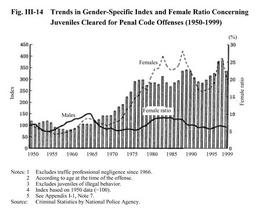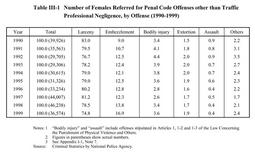| Previous Next Index Image Index Year Selection | |
|
|
1 Delinquency among females Fig. III-14 shows the gender-specific index(1950=100)and the female ratio(ratio of females in the total)for juveniles cleared for penal code offenses since 1950.
While the index for males has fluctuated within the range of70-150,the index for females rose rapidly from the early1970s and peaked at422in1988. The latter index then continued to decline until1993,but began to move up in1994. In1999,however, it fell by82from the previous year to310. The female ratio remained at around20%with some fluctuations from1976but rose to about25%in1997,followed by a record high of25.4%in1998. In1999,it dropped3.1points from the previous year to22.3%. Fig. III-14 Trends in Gender-Specific Index and Female Ratio Concerning Juveniles Cleared for Penal Code Offenses(1950-1999) Table III-1 shows the number of females cleared for penal code offenses other than traffic professional negligence in the last10years, by category of offense.Within this ten-year period, the number of females cleared for penal code offenses declined until1993and increased from1994. In1999,however, it fell by9,664(20.9%)from the previous year to36,574. By offense, larceny had an overwhelming majority in every year, but the ratio of embezzlement(including conversion of lost property)has been rising. The two offenses combined continue to account for about90%of the total. Females referred by the police for special law offenses other than traffic-related law violations numbered2,519in1999(down2.8%from the previous year). Poisonous and Deleterious Substances Control Law violations had the largest share with1,752(up1.7%), followed by Stimulant Drug Control Law violations with494(down8.0%)and others with273(down17.8%). Thus, drug offenses account for an overwhelming majority of females referred for special law offenses. Table III-1 Number of Females Referred for Penal Code Offenses other than Traffic Professional Negligence, by Offense(1990-1999) Delinquency by females typically involves sexual deviance. The number of females given guidance or protection for sexual deviance in1999declined by35(0.8%)from the previous year to4,475(source:Living Safety Bureau, National Police Agency). |

